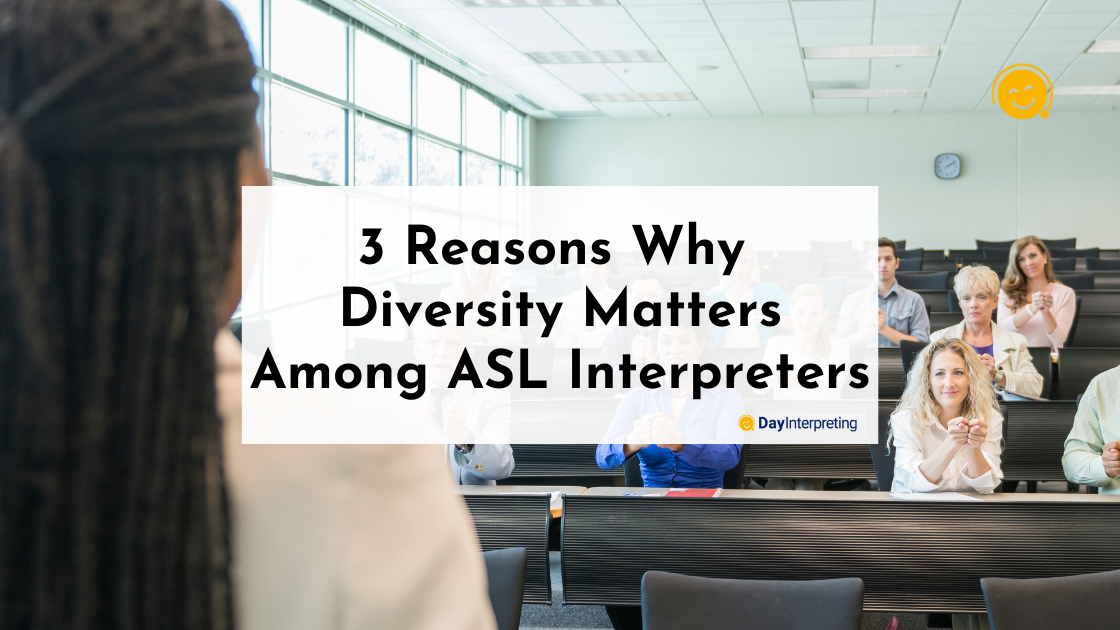There are so many reasons why diversity matters among ASL interpreters.
However, there’s a real diversity problem in American Sign Language interpreting. In the United States, 85% of interpreters working with the Deaf community identify as Caucasian. And shockingly, just 15% identify as ethnic minorities.
Those stats are in stark contrast to the broader population of the US. A contrast that can lead to a plethora of issues, including a lack of trust and mistranslations.
So, with that said, let’s look at why this is a problem and why diversity matters!
Why Inclusion and Diversity Matters Among ASL Interpreters
ASL and Sign Language Interpreters Have Different Dialects
Have you ever talked to someone that speaks a different English dialect? Did you experience how different it is from the dialect you speak? The same concept rings true for ASL communities.
Black American Sign Language (Black ASL), for example, developed from historical circumstances like racial segregation in Deaf Schools in the South. But other dialects emerged to create entirely new dialects. A good example here is Puerto Rican Sign Language, born from American and Spanish sign language, .
Just like spoken languages, American Sign Language changes and evolves. These changes are based on local, regional, and cultural differences. And those differences can lead to a communication struggle between interpreters and speakers of diverse sign languages.
In order to meet their diverse language needs, it’s critical to understand how deaf people communicate with each other. You also need education on their specific sign language dialect for effective interpretation. Even if they’re familiar with standard ASL, you still need to address them in their community dialect.
So, ASL interpreters that understand the ethnic, community, and regional dialects are better equipped to assist Deaf people since they have a deep understanding of their unique dialect.
Inclusion and Diversity in ASL Interpreting Builds Trust in Deaf Communities
Aside from differences in dialects, African American minorities that need sign language interpreting might fall victim to discrimination due to their background. And just like their hearing counterparts, it can be hard to build trust with people within the community that are in high-ranking positions.
Sadly, there’s a long history of racial discrimination in fields like medical and legal in the United States. Caucasian ASL interpreters that work within a community often do not understand the cultural barriers involved in the process of building trust and gaining access to language services. They might miss subtle cultural nuances. And if you miss subtle cultural nuances, you risk losing vital information in the translation process.
But when they can work with an interpreter that has a mutual understanding of this cultural background, deaf people are more likely to trust the interpreter and feel like they are genuinely heard and understood.
Diversification and Inclusion Inspires Future Sign Language Interpreting Students Among Deaf Community Members
Two of the most significant barriers in minority sign language interpreting face are access to higher education and the cost involved in certification. This is true across the board for sign language interpreters, regardless of whether they are Deaf or hearing.
But before they can encounter these barriers, they must first feel inspired to consider sign language interpreting as a career. And this is where diversity, inclusion, and visibility play a significant role. Seeing minority sign language interpreters makes it that much easier for young people to dream about these kinds of roles because they know it’s a possibility.
Plus inclusion and visibility can also help raise awareness among the general public to understand the Deaf community better. Naturally, it can also lead to more funding to address the financial barriers involved in sign language interpreting.
Wrapping Up
Training, recruiting, and employing ASL interpreters from diverse backgrounds is no easy feat. But it’s something that language service providers need to pay attention to and focus on. Inclusivity efforts always improve communication and outcome. But this kind of effort can also help reduce inequality and inspire future interpreters.
Here at Day Interpreting, we have a strong diversity, equity, and inclusion policy that includes diverse ASL interpreters from all walks of life and all cultural backgrounds. We are proud supporters of initiatives like the National Multicultural Interpreter Project that are driving change in the interpreting field. Thanks to programs like these, it is becoming easier for the average African American black interpreter and Asian American interpreter to join the board of certified interpreters and support the notion of equal language access.
How about your organization? What do your inclusion policies look like?





0 Comments